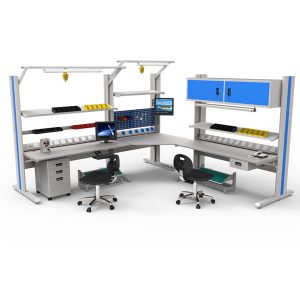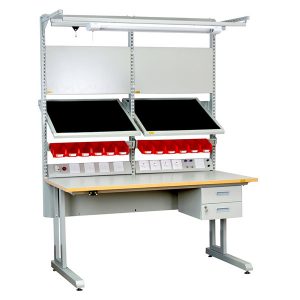Designing the best ESD (Electrostatic Discharge) furniture involves incorporating features that effectively control static electricity and meet the specific needs of your ESD-sensitive environment. Here are some considerations for designing the best ESD furniture:
1. Static Control Materials: Use materials with inherent static-dissipative or conductive properties in the construction of ESD furniture. Consider options such as static-dissipative laminates, conductive metals, or static-dissipative plastics. These materials prevent the buildup and discharge of static electricity.
2. Work Surface: The work surface of ESD furniture should have a low resistance to allow for controlled dissipation of static charges. Choose materials that are static-dissipative, conductive, or have a special ESD coating. The surface should be smooth, easy to clean, and resistant to scratching or abrasion.
3. Grounding: Ensure proper grounding provisions in the design of ESD furniture. This includes grounding points or blocks that allow for easy connection of grounding cords or cables to establish a direct path to ground. Proper grounding helps divert static charges away from sensitive equipment or components.
4. ESD Accessories Integration: Design the furniture to accommodate ESD accessories such as wrist strap connections, grounding points, and storage options for ESD-sensitive components or tools. Integrated holders, shelves, or cable management systems for ESD accessories help keep them organized and within reach.
5. Ergonomics and Comfort: Prioritize ergonomic design to promote comfort and productivity. Consider adjustable height options, ergonomic accessories (e.g., adjustable monitor arms, keyboard trays), and features like anti-fatigue mats to reduce strain and improve overall working conditions.
6. Cable Management: Incorporate effective cable management features to organize and route cables properly. This helps prevent cable tangling, reduces the risk of tripping hazards, and maintains a neat and clutter-free workspace.
7. Customization Options: Provide flexibility for customization based on specific requirements. Offer different sizes, configurations, and additional features to accommodate the needs of your workspace and workflow. Customization options can include adjustable shelves, modular components, or the ability to integrate additional accessories.
8. Compliance with ESD Standards: Ensure that the design of ESD furniture complies with relevant industry standards and guidelines, such as ANSI/ESD S20.20 or IEC 61340-5-1. Compliance ensures that the furniture meets specific requirements for ESD control and safety.
9. Durability and Maintenance: Design ESD furniture with durability and easy maintenance in mind. Select materials that are resistant to wear, easy to clean, and capable of withstanding the demands of the work environment. Consider factors such as chemical resistance, scratch resistance, and overall structural integrity.
10. Safety Considerations: Integrate safety features into the design of ESD furniture. This may include rounded edges to prevent injuries, anti-slip surfaces, stability enhancements, or locking mechanisms for mobile furniture.
It is important to consult with ESD experts, manufacturers, or specialists in ESD control to ensure that the design of your ESD furniture meets your specific requirements and adheres to industry best practices.
By considering these factors, you can design ESD furniture that effectively controls static electricity and creates a safe environment for ESD-sensitive operations.

No comments yet